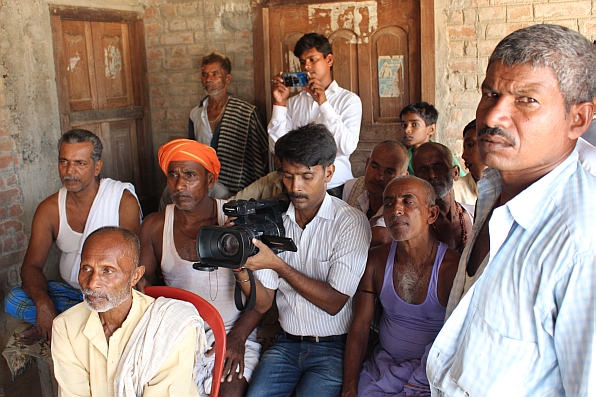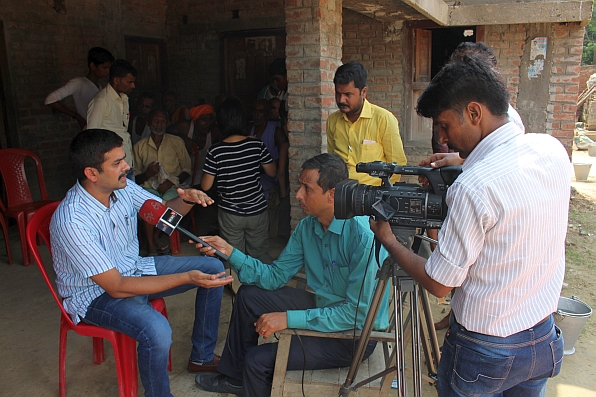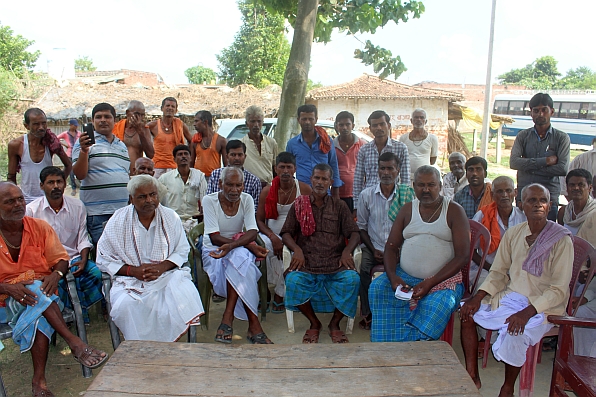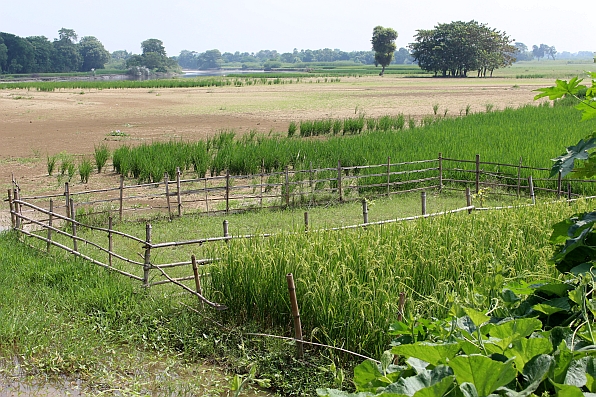The dramatic debut of index-based flood insurance in India
Smallholder farmers in India’s flood-prone Bihar State can recite a long history of broken promises from agencies whose job is to provide them with much-needed support. So, it came as no surprise during a recent media visit to Ladaura village in Muzaffarpur District that the first question on the minds of farmers who had signed up for index-based flooding insurance was how big the compensation payment would be after the worst flooding northern Bihar has seen in nearly two decades.

Photo: Nathan Russell/IWMI
They should get a clear answer in the coming weeks, when the Agricultural Insurance Company of India (AICI) has completed its assessment of satellite and other data showing the severity and exact location of crop damage in their fields. In the meantime, researchers generating the data are in a state of mild suspense as well, while they complete field work and analysis aimed at “ground truthing” the results from hydrological modeling and remote sensing.
The effort is led by Giriraj Amarnath, leader of the Water Risks Research Group at the International Water Management Institute (IWMI). In collaboration with the Indian Council of Agricultural Research (ICAR), his team is piloting the novel insurance product this year with 200 farm households in six villages through the CGIAR Research Programs on Water, Land and Ecosystems (WLE) and Climate Change, Food and Agriculture (CCFAS), supported by CGIAR Fund donors.
Heavily subsidized at this initial stage, the risk-transfer product covers rice crops during the 2017 monsoon season (from the beginning of July to the end of October), with a total insured value of about USD 78,000. Any payouts will go directly to local bank accounts created for individual farmers under a government safety net program.

For the farmers and researchers as well as the half dozen journalists who accompanied them in the sweltering heat at Ladaura, it would have been hard to imagine a more fitting topic to discuss in the run-up to the International Day for Disaster Reduction, which falls inauspiciously this year on Friday, October 13.
The media visit also included Madhura Patti Urf Manorathpatt village, where farmers expressed great satisfaction with the transparent process through which researchers had proposed index-based flood insurance and with their periodic visits to monitor developments in the field. The farmers’ reaction pinpointed the central issue on which the eventual success of this approach depends: It all comes down to confidence in the process.

With conventional crop insurance, payouts depend on field measurement of crop damage, accompanied by a time-consuming process of review and approval. As a result, farmers generally do not receive compensation until well into the next year after crop damage has occurred. Moreover, the process is not entirely clear to them, giving rise to expectations that may or may not be realistic. Such is the case for a new USD 1.3 billion initiative being implemented by the Indian government – called the Prime Minister’s Crop Insurance Scheme or Pradhan Mantri Fasal Bima Yojana (PMFBY) in Hindi.
With index-based flood insurance, in contrast, the payout should be not only transparent but also much faster, because the insurer’s assessment depends on results from modeling and remote sensing. For this purpose, IWMI researchers developed a hydrological model, based on 35 years of observed rainfall and related data. When such data for the current year are fed into the model, it predicts where runoff water will collect. If the modeling shows that a threshold water level has been exceeded, researchers then use high-resolution satellite images to determine the depth, duration and extent of the flooding. Rice fields flooded for 8 days or less are, in general, not seriously damaged. But where flooding persists for 23 days or more, the likely result is total crop loss.

Photo: Nathan Russell/IWMI
Incorporating this approach into schemes such as PMFBY on a large scale could generate enormous benefits for farmers and the wider rural economy. What remains to be seen is whether farmers, insurers and government supporters are prepared to make and accept decisions based on the scientific concepts and procedures on which index-based flood insurance is based.
If they are, this will usefully complement other technologies aimed at enhancing the resilience of Bihar’s predominant rice-wheat rotation. One approach encompasses various post-flood management options identified and tested by the Indian Institute of Water Management (ICAR-IIWM). These offer farmers the possibility of planting alternative crops (maize, potato, water chestnut and others) as soon as flood waters recede from their rice fields, leaving behind residual moisture and nutrients.
A key advantage of this approach is that it widens the scope for ensuring that benefits are shared more equally between men and women as well as with marginalized groups in rural communities. These issues are a central focus of IWMI/WLE research on index-based flood insurance, which provides not a panacea but a major piece in the puzzle of risk resilience.
Index-based flood insurance has received a lot of attention lately. Reported in the most recent issue of Geospatial World magazine, it was also on the agenda at the Fifth Session of the Committee on Disaster Risk Reduction, organized in Bangkok, Thailand, this week by the UN Economic and Social Commission for Asia and the Pacific (ESCAP). The product certainly piqued the curiosity of journalists taking part in a recent media visit, presumably because the pilot is a first for this country and comes at a time of heightened visibility for water-related disasters in India and elsewhere.
The visit offered a good example of “how people and communities around the world are reducing their exposure to disasters and raising awareness about the importance of reining in the risks they face.” This is the objective of a global campaign led by the United Nations Office for Disaster Risk Reduction (UNISDR) to reach the seven targets of the Sendai Framework for Disaster Risk Reduction. Approved by the United Nations General Assembly in 2015, the framework is a 15-year, voluntary effort, which recognizes that governments play a primary role in reducing disaster risk, while sharing responsibility with the private sector and others.

